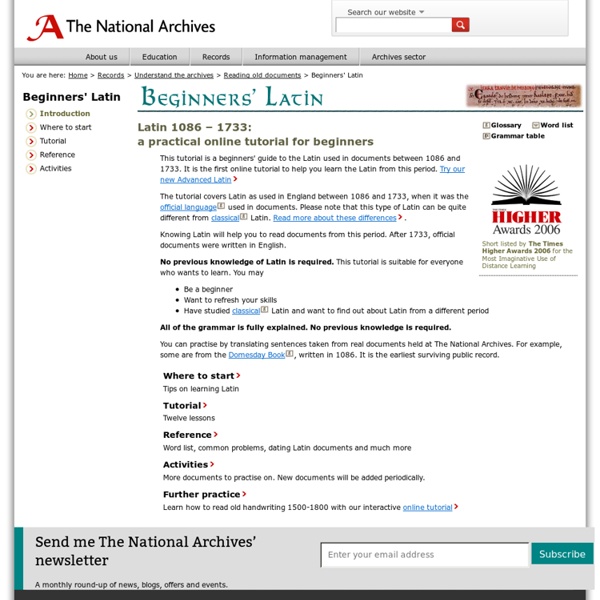Secrets of Lost Empires
by Dennis Gaffney Aqueducts are one of the wonders of the Roman Empire. These graceful structures are not only majestic, but are engineering marvels that survive to this day. In "Construct an Aqueduct," you are hired as Chief Water Engineer by the Roman Emperor.
The LatinStudy List
“Non enim tam praeclarum est scire Latine quam turpe nescire.” (It is not so excellent to know Latin, as it is a shame not to know it.) — Cicero LatinStudy is an open mailing list dedicated to the study of Latin, including Classical, Medieval, and Neo-Latin authors. Both beginners and experienced Latinists will find something of interest here. Basic Information The LatinStudy list is shared by multiple study groups.
Basics in music acoustics
Music Acoustics: Basics Some basic questions about the science of music are listed here. There is also a non-specialist Frequently Asked Questions in music acoustics on this site. General topics String topics
Latin Teaching Materials at Saint Louis University: Teach & Learn the Latin Language
These materials present the essentials of beginning and intermediate Latin morphology. In addition, you can find a summary of the vocabulary for Wheelock's Latin (6th Edition), other vocabulary studies, and some Flash movies for elementary Latin acquisition. LatinPraxis is a series of exercises correlated with the same text, using thousands and thousands of short phrases and sentences to help students achieve mastery of vocabulary and forms as well as an immediacy of understanding. For the theory of this phrase-based approach to second-language-acquisition, read "Upgrading Latin Pedagogy."
Latin Handouts
Grammar Handouts: Vocabulary Handouts: Lingua Latina:
Music Acoustics, Physics, Science, UNSW
Physics and music have been related for millenia. The art and science of music acoustics are presented here, in musician-friendly format, as is our research in music science. Navigate using the headings and images above, the site map or 'search'. News
A.LATIN ACADEMY. IMPARARE IL LATINO CON UN’APP – cgmagazine.it
di PAOLA D’ANGELO L’utilizzo di piattaforme informatiche per l’apprendimento delle lingue antiche è la novità più vistosa degli ultimi anni nel campo della didattica del latino e del greco: una novità che sta prendendo sempre più piede tra i docenti, pur dovendo ancora vincere le resistenze di quanti non sono convinti che l’utilizzo di strumenti multimediali sia un effettivo supporto alla didattica e una valida alternativa ai modelli di insegnamento-apprendimento tradizionali. Tra le piattaforme digitali apparse di recente si segnala Alatin Academy, la cui diffusione cresce di mese in mese, nonostante sia l’ultima nata del settore, lanciata appunto a ottobre 2015. L’organizzazione di Alatin è semplice: 160 unità (con obiettivi di apprendimento), suddivise in 41 missioni, raggruppate in 12 livelli. Ogni unità (ad es.
Greek and Latin Learning Tools
University of Michigan
Il grecoantico: versioni, cultura, testi, letteratura
Un cammino di lettura nei testi dell’antica Grecia Presentazione Il corso online La vecchiaia. Un cammino di lettura nei testi dell’antica Grecia propone di rileggere il fenomeno della vecchiaia, sulla base della lettura diretta di testi, che offriranno un panorama vasto ed eterogeneo, per verificare come – nel mondo greco antico – venisse elaborata la percezione di questo fenomeno. Il quadro che emergerà non ha certo la pretesa di essere esaustivo, ma solo di offrire un significativo confronto con le voci della poesia greca antica (nei suoi vari generi, dall’epica, alla lirica, al teatro) che possono esercitare una viva suggestione anche nel mondo attuale. Modalità di svolgimento



